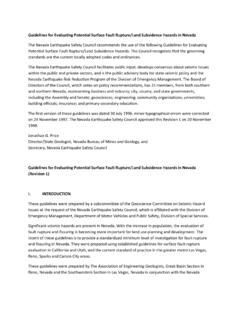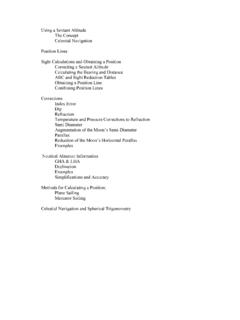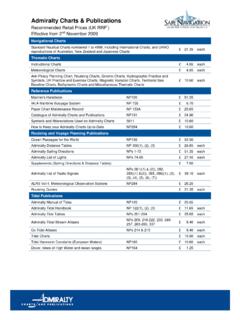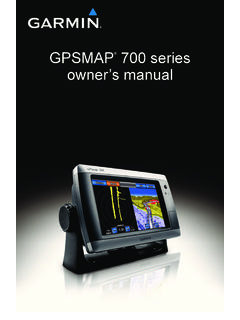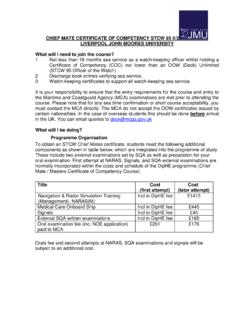Transcription of Basics of the GPS Technique: Observation Equations
1 Basics of the GPS technique : Observation Equations . Geoffrey Blewitt Department of Geomatics, University of Newcastle Newcastle upon Tyne, NE1 7RU, United Kingdom Table of Contents 1. 2. GPS DESCRIPTION ..2. THE BASIC IDEA ..2. THE GPS THE GPS SIGNALS ..6. 3. THE PSEUDORANGE OBSERVABLE ..8. CODE AUTOCORRELATION technique ..12. PSEUDORANGE Observation Equations ..13. 4. POINT POSITIONING USING PSEUDORANGE ..15. LEAST SQUARES ESTIMATION ..15. ERROR COMPUTATION ..18. 5. THE CARRIER PHASE OBSERVABLE ..22. CARRIER PHASE Observation DIFFERENCING TECHNIQUES ..32. 6. RELATIVE POSITIONING USING CARRIER SELECTION OF BASELINE SOLUTION USING DOUBLE DIFFERENCES.
2 39. STOCHASTIC MODEL ..42. 7. INTRODUCING HIGH PRECISION GPS HIGH PRECISION SOFTWARE ..44. SOURCES OF DATA AND INFORMATION ..45. 8. CONCLUSIONS ..46.. Copyright 1997 by the author. All rights reserved. Appears in the textbook Geodetic Applications of GPS, published by the Swedish Land Survey. 1. 2 GEOFFREY BLEWITT: Basics OF THE GPS technique . 1. INTRODUCTION. The purpose of this paper is to introduce the principles of GPS theory, and to provide a background for more advanced material. With that in mind, some of the theoretical treatment has been simplified to provide a starting point for a mathematically literate user of GPS who wishes to understand how GPS works, and to get a basic grasp of GPS theory and terminology.
3 It is therefore not intended to serve as a reference for experienced researchers;. however, my hope is that it might also prove interesting to the more advanced reader, who might appreciate some easy reading of a familiar story in a relatively short text (and no doubt, from a slightly different angle). 2. GPS DESCRIPTION. In this section we introduce the basic idea behind GPS, and provide some facts and statistics to describe various aspects of the Global Positionining System. THE BASIC IDEA. GPS positioning is based on trilateration, which is the method of determining position by measuring distances to points at known coordinates.
4 At a minimum, trilateration requires 3. ranges to 3 known points. GPS point positioning, on the other hand, requires 4. pseudoranges to 4 satellites. This raises two questions: (a) What are pseudoranges? , and (b) How do we know the position of the satellites? Without getting into too much detail at this point, we address the second question first. How do we know position of satellites? A signal is transmitted from each satellite in the direction of the Earth. This signal is encoded with the Navigation Message, which can be read by the user's GPS receivers. The Navigation Message includes orbit parameters (often called the broadcast ephemeris ), from which the receiver can compute satellite coordinates (X,Y,Z).
5 These are Cartesian coordinates in a geocentric system, known as WGS-84, which has its origin at the Earth centre of mass, Z. axis pointing towards the North Pole, X pointing towards the Prime Meridian (which crosses Greenwich), and Y at right angles to X and Z to form a right-handed orthogonal coordinate system. The algorithm which transforms the orbit parameters into WGS-84 satellite coordinates at any specified time is called the Ephemeris Algorithm, which is defined in GPS textbooks [ , Leick, 1991]. We discuss the Navigation Message in more detail later on. For now, we move on to pseudoranges.. What are pseudoranges?
6 Time that the signal is transmitted from the satellite is encoded on the signal, using the time according to an atomic clock onboard the satellite. Time of signal reception is recorded by receiver using an atomic clock. A receiver measures difference in these times: GEOFFREY BLEWITT: Basics OF THE GPS technique 3. pseudorange = (time difference) (speed of light). Note that pseudorange is almost like range, except that it includes clock errors because the receiver clocks are far from perfect. How do we correct for clock errors? How do we correct for clock errors? Satellite clock error is given in Navigation Message, in the form of a polynomial.
7 The unknown receiver clock error can be estimated by the user along with unknown station coordinates. There are 4 unknowns; hence we need a minimum of 4 pseudorange measurements. THE GPS SEGMENTS. There are four GPS segments: the Space Segment, which includes the constellation of GPS satellites, which transmit the signals to the user;. the Control Segment, which is responsible for the monitoring and operation of the Space Segment, the User Segment, which includes user hardware and processing software for positioning, navigation, and timing applications;. the Ground Segment, which includes civilian tracking networks that provide the User Segment with reference control, precise ephemerides, and real time services (DGPS) which mitigate the effects of selective availability (a topic to be discussed later).
8 Before getting into the details of the GPS signal, Observation models, and position computations, we first provide more information on the Space Segment and the Control Segment. Orbit Design The satellite constellation is designed to have at least 4 satellites in view anywhere, anytime, to a user on the ground. For this purpose, there are nominally 24 GPS satellites distributed in 6 orbital planes. So that we may discuss the orbit design and the implications of that design, we must digress for a short while to explain the geometry of the GPS constellation. According to Kepler's laws of orbital motion, each orbit takes the approximate shape of an ellipse, with the Earth's centre of mass at the focus of the ellipse.
9 For a GPS orbit, the eccentricity of the ellipse is so small ( ) that it is almost circular. The semi-major axis (largest radius) of the ellipse is approximately 26,600 km, or approximately 4 Earth radii. The 6 orbital planes rise over the equator at an inclination angle of 55o to the equator. The point at which they rise from the Southern to Northern Hemisphere across the equator is called the Right Ascension of the ascending node . Since the orbital planes are evenly distributed, the angle between the six ascending nodes is 60o. 4 GEOFFREY BLEWITT: Basics OF THE GPS technique . Each orbital plane nominally contains 4 satellites, which are generally not spaced evenly around the ellipse.
10 Therefore, the angle of the satellite within its own orbital plane, the true anomaly , is only approximately spaced by 90o. The true anomaly is measured from the point of closest approach to the Earth (the perigee). (We note here that there are other types of anomaly in GPS terminology, which are angles that are useful for calculating the satellite coordinates within its orbital plane). Note that instead of specifying the satellite's anomaly at every relevant time, we could equivalently specify the time that the satellite had passed perigee, and then compute the satellites future position based on the known laws of motion of the satellite around an ellipse.
